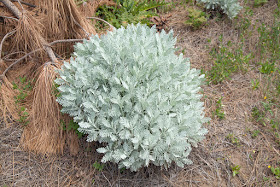 |
| Silver Leaf, Silver Feather, silver tansy, Magarza Plateada — common names describe the silvery leaves of the plant. Taken mid-May, in a relatively shady spot |
I first noticed unusual-looking leaves of this plant in early spring last year. They were growing in compact round bushes, something between 40 cm and 80 cm in height. The color of the leaves was very distinct — light cyan. When you look closely at the leaves, you notice they are covered with short white fluff. The shape of each leave is very neat, Irish lace-like.
I made a note to myself to find out what the plants were. They turned out to be Tanacetum ptarmiciflorum, Gran Canaria endemic and endangered species according to the IUCN (International Union for Conservation of Nature) Red List. I like plants in general, but finding something endemic and rare is always more pleasing. Especially when something in question is beautiful.
 |
| Young, relatively small, bush, probably not going to produce flowers this year, pic taken end of April |
If you follow the link to the Red List, you will see that the whole estimated area of occupancy is just 4 square kilometers, and that the population is severely fragmented. One of the dangers that the species are facing is trampling by hikers — and that I can easily believe because the biggest patch of them I’ve seen (I’d say over a hundred plants out of overall estimated population of 541) is right next to a popular hiking route Cruz de Tejeda — Artenara.
 |
| Bigger and older specimen, inflorescence spike already tall, no flowers yet, taken beginning of May |
 |
| Arguably the most attractive part of the plant — beautiful lacy light-cyan leaves. End of April |
According to the same Red List entry, currently accepted name is Gonospermum ptarmiciflorum, and the genus Gonospermum is endemic to Canary Islands. While I can understand the necessity to separate something unique to Canary islands from ubiquitous Tanacetum (Tansy), the new name undoubtedly resemble something to do with sexually transmitted diseases. I like the old one better.
It amused me initially to see that Russian version of the name was “Пижма чихательная”, i.e. sneeze-producing tansy. Then I decided to check out what exactly is ptarmiciflorum and yep, that is exactly what it means.
 |
| Sun-exposed plant in full bloom, Degollada de Becerra, end of May |
When the blooming starts, it is quite spectacular — plants are completely covered in white flowers. The flowering spikes are high, and the bushes increase to about twice their usual size. During this time, if you stand on Cruz de Tejeda and look right, to the steep northern walls of the Caldera de Tejeda, you can see white patches of flowers between the pine trees.
And this is where you need to go to see the mass flowering close up — take a path towards Artenara, you will find them growing close to the path at about 3 km.
 |
| Plants about to finish blooming, Cruz de Tejeda, partially shaded location, end of June |
The path is relatively easy, but since we are already talking more than 1500 meters above sea level, it can be a bit tricky without a good walking habit. So, there are shortcuts. First, the Hotel Parador Cruz de Tejeda planted a few native flowers around — mountain scabious grows in a square patch to the right of the hotel entrance, and there are four (IIRC) mature bushes of Silver Tansy along the road to the main car park behind the hotel.
Another spot which is easily reachable, albeit by car, is Degollada de Becerra. There is an almost-finished building there (I believe it is meant to be a visitor center), surrounded by a wire fence. There are a few plants inside the fence and at least one mature one outside, to the left of the mirador.
Yet another place where I’ve spotted one fenced (!) flowering plant is Mirador Degollada de Las Palomas, on the slope just below the mirador itself.
A few more pics from mid-May, when the flowers only started to open in shady spots:
I have marked the times I took the pictures. This year the flowering I saw started mid-May and finished about the end of June. I assume flowering time depends on the spot, plants that are getting full sun are likely to start and finish earlier.
Pics of flora of Gran Canaria on Shutterstock.
Text and pictures by Tamara



No comments:
Post a Comment